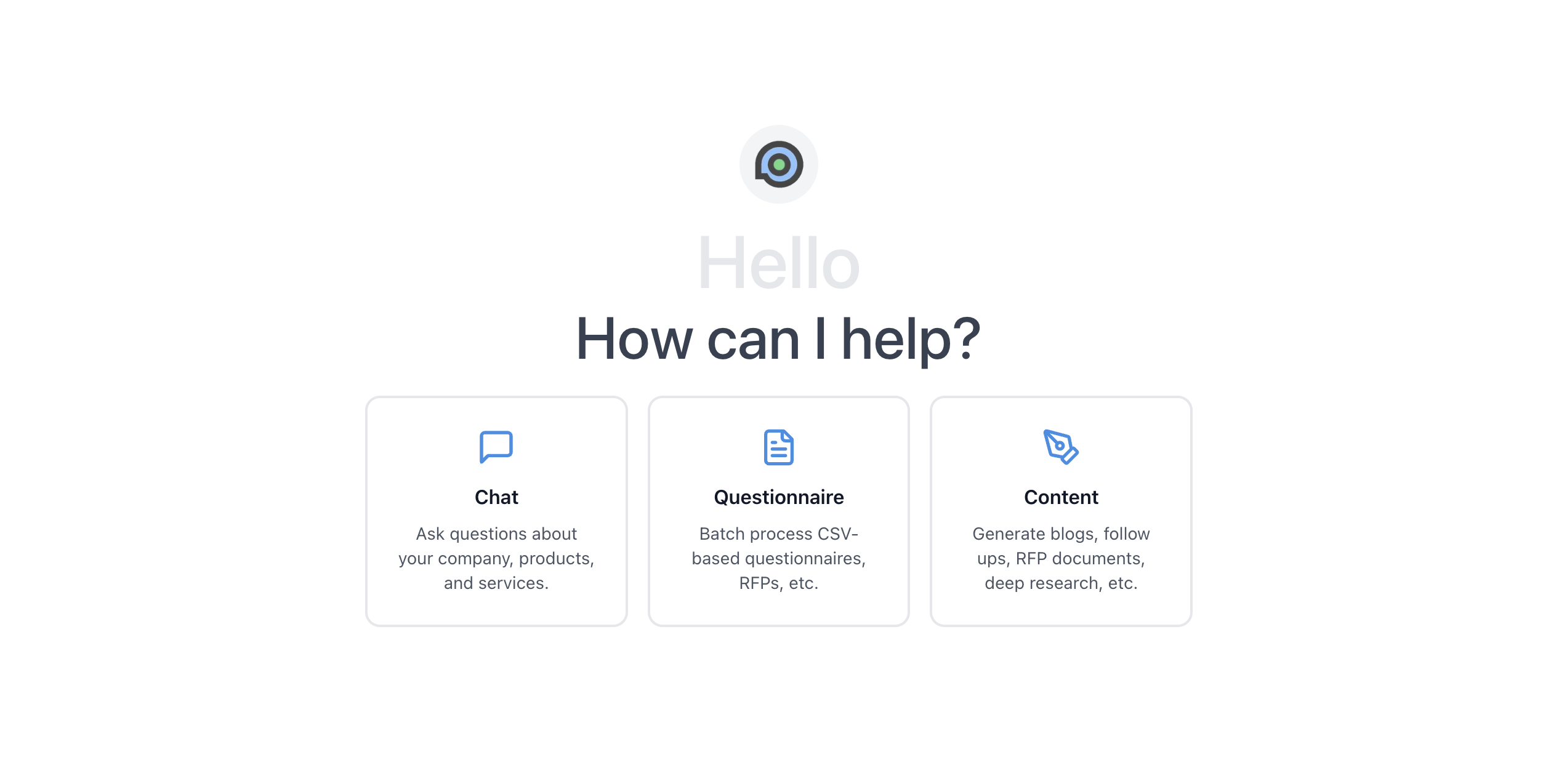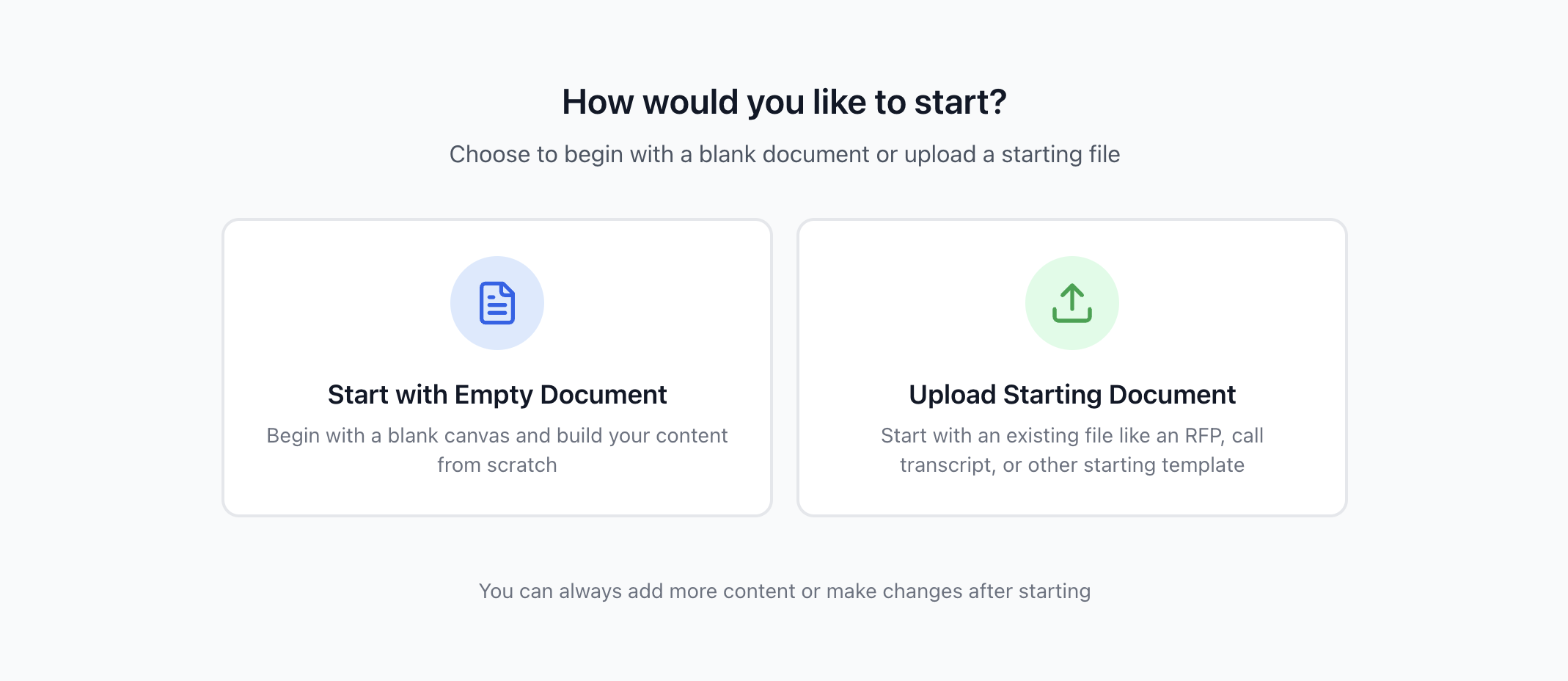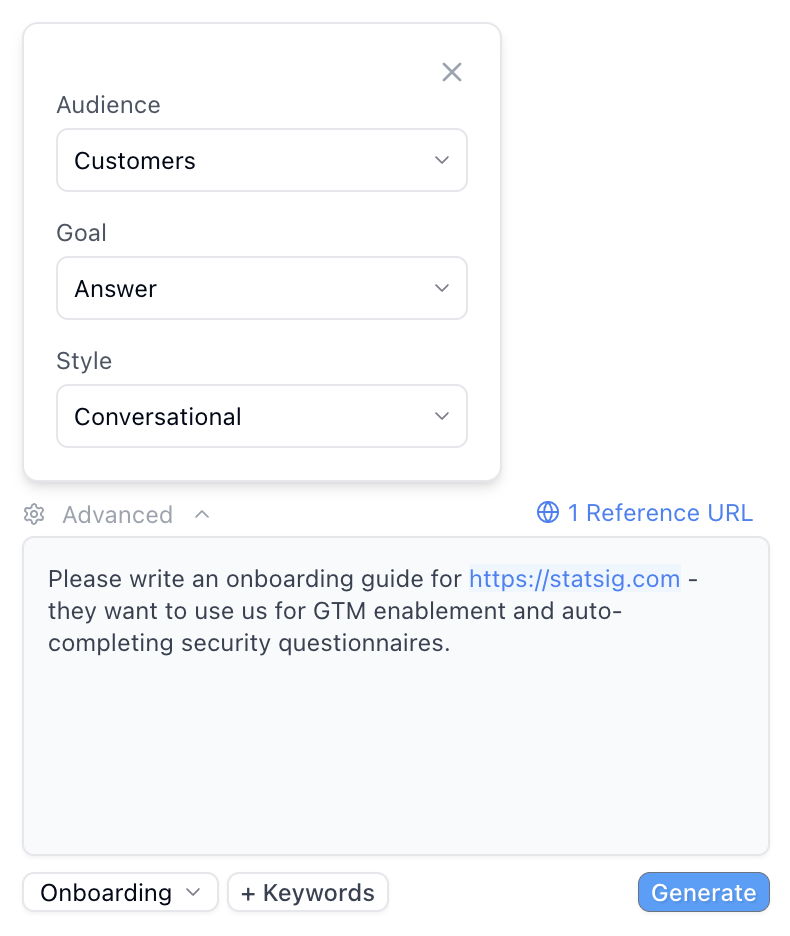Content
Last updated: 6 days agoContent mode helps you create high-quality written content including blogs, follow ups, RFP documents, onboarding guides, and more using oper8r.

Getting Started
To start a new content generation, open the left side nav, and click + New Session then click the Content option.

Then, you can choose to either start with a blank document, or upload a document that you want to work on. For example you might want to start with: A blank RFP file, a call transcript file, or some other starting document.

The Rich Text Editor
On the left side, you will see the content editor. This is an interactive editor that allows you to write and edit rich content. You can start typing, and oper8r will automatically save your content as you go.
The tool bar at the top of the editor allows you to edit the title of your content, copy your content as markdown or plain text, undo/redo edits, bold, italic, underline, choose text type, and add lists, links, code blocks or tables.

Content Generation Settings
On the right hand side, you will see the oper8r content generation input and message history. This is where you can adjust content settings, add reference URLs, add keywords and give specific directions to oper8r.

Keywords
If you are writing a blog or social post, keywords allow you to tell oper8r which keywords you want to target. oper8r will search each of these keywords, and analyze the top content for each keyword, to learn the type of content and structure that's ranking for these keywords. oper8r will apply these learnings to the content you are trying to generate.
Click the Keywords button under the input; this will open an option to enter the keywords that you want to target. Each keyword must be between 2-6 words, and you can enter up to 3 keywords.
Type
By clicking the Type button under the input, you can specify what type of content you're trying to create. These are the current content types, and prompts that are injected based on each selection:
| Setting | Prompt Addition |
|---|---|
| Blog | Format as a blog post, the cornerstone of our 95/5 strategy. The rule is no direct product talk. Focus entirely on solving a real, frustrating problem for the audience. Use storytelling and insider language to build trust and authority. |
| Follow Up | Format as a strategic follow-up communication based on the provided conversation transcript or email thread. In a SaaS GTM context, a follow-up is not just a reply; it is an action designed to build momentum, demonstrate value, and guide the prospect to the next logical step. Your response must be crafted with the following methodology: 1. Deconstruct the Context: Analyze the provided transcript/thread to precisely identify the other party's key themes, direct questions, and any action items you committed to. 2. Maintain an Authentic Voice: Analyze the user's previous messages in the thread to replicate their tone, style, and vocabulary (e.g., formal vs. conversational, sentence structure, use of pleasantries). The follow-up must feel like it came from them. 3. Structure for Clarity and Impact: Begin by referencing the previous conversation. Reiterate your understanding of their primary goal to show you were listening. Address their questions directly and clearly, using bullet points for readability. If you promised to provide information, deliver it here. 4. Add Value Beyond the Ask: Where possible, include a relevant resource (e.g., a case study, a blog post, a technical doc) that further helps them with their problem. 5. Drive the Conversation Forward: The conclusion MUST contain a specific, unambiguous, and low-friction next step (e.g., 'Do you have 30 minutes on Thursday to do a deeper dive?' or 'I've attached the proposal; I'll follow up on Friday to discuss'). |
| Format as a LinkedIn post. Start with a strong, relatable hook that captures a common professional frustration. For awareness (95%), focus the post on discussing the problem. For promotion (5%), transition from the problem to the value-driven outcome. | |
| Onboarding | Format as an onboarding guide for the 5%. Guide the new user to their first 'aha!' moment. Frame each step not as a task to complete, but as an action that directly solves the core problem that brought them here. |
| Format as a Reddit post. Your goal is to provide genuine value and avoid any hint of marketing. Adopt the subreddit's authentic tone, solve a problem, and spark a discussion. This is a pure 95% play to build community trust. | |
| Research | Format as a formal research report. Uncover and analyze a key problem or trend affecting the 95%. The report should establish the brand as a primary data source and thought leader in the audience's ecosystem. |
| RFP | Format the output as a comprehensive and persuasive response to a Request for Proposal (RFP). In a high-stakes SaaS sales cycle, an RFP response is a critical sales document. The goal is not just to answer questions compliantly, but to demonstrate a deep understanding of the customer's business needs and position our solution as the superior strategic choice. Your response must be generated using these principles: 1. Strictly Adhere to Structure: If a customer's RFP template or a pre-formatted structure is provided in the input, you MUST use that exact structure. Your primary task is to fill in the sections and answer the questions precisely as they are laid out, maintaining all original numbering and headings. 2. Map Requirements to Outcomes, Not Just Features: For each requirement or question in the RFP, your answer must go beyond a simple 'yes/no' or a feature name. First, confirm you meet the requirement. Then, explain how the relevant feature works and, most importantly, describe the business outcome or value that feature delivers. For example, instead of 'Yes, we have role-based access control,' write 'Yes, our platform provides granular Role-Based Access Control (RBAC). This allows you to enforce security policies effortlessly, ensuring that team members only access data relevant to their roles, thereby minimizing security risks and simplifying compliance audits.' 3. Infuse Company Differentiators: Where appropriate within the provided structure, weave in the company's key competitive differentiators (e.g., superior ease of use, faster time-to-value, dedicated customer support model, unique technical architecture). 4. Maintain a Professional & Confident Tone: The voice must be that of a trusted, expert partner. The tone should be professional, confident, and meticulously detailed, reflecting the seriousness of the proposal. |
| Tutorial | Format as a detailed tutorial. If the tutorial is about a general problem (95%), do not mention the product. If it's about the product or a product feature (5%), frame the tutorial as a step by step guide on how to solve frustrating problem or achieve a use case or end goal. |
Reference URLs
Any URL that you paste into the agent input will be validated and highlighted. During the content generation process, oper8r will scrape these URLs and use the scaped content as reference material when generating your content.
Prompt Library
This allows you to apply any saved prompts that you have created. You can learn more about your prompt library here.
Advanced Settings
To further refine your content generation, click the Advanced option just above the input to open the advanced settings panel. The current advanced settings you can specify are:
Audience
Audience allows you to specify your intended audience. Each audience selection applies specific prompting strategies based on the 95/5 content marketing framework:
| Setting | Prompt Addition |
|---|---|
| Advanced | Your audience is Advanced. They are deep in the 95% and value nuanced, contrarian takes. Challenge their existing understanding of a problem. Your goal is to earn their respect by demonstrating a superior grasp of their world, making them think, 'Finally, someone who gets it.' |
| Beginners | Your audience is Beginners, part of the 95% who are problem-aware but solution-unaware. Your tone must be an encouraging peer who remembers what it was like to be new. Define key terms, but frame all instructions around solving the foundational frustrations they are just now encountering. |
| Customers | Your audience is existing Customers, a crucial part of the 5%. They've already bought in. Your goal is to help them achieve mastery. Focus on advanced use cases and best practices that solve a deeper, secondary problem, reinforcing their decision and turning them into advocates. |
| Developers | Your audience is Developers. To earn their trust, anchor your technical content in a common developer frustration. Use the 'in medias res' technique: start with a relatable problem (e.g., 'a broken build on a Friday') before presenting the technical solution or advice. |
| Executives | Your audience is Executives. They operate on problems and outcomes. For the 95%, frame their problems in terms of strategic business impact (e.g., risk, opportunity, efficiency). For the 5%, frame product outcomes in terms of ROI and competitive advantage. Be concise and direct. |
| Intermediate | Your audience is Intermediate. They understand the problem space. Your content must provide non-obvious, actionable advice they can use immediately. Use their insider language to show you're 'one of them' and build the trust needed to nurture this 95% segment. |
| Investors | Your audience is Investors. This is a 5% audience. Be direct and data-driven. Frame the company, product, and market in terms of growth potential, total addressable market (TAM), and competitive moats. Your goal is to instill confidence through a clear, compelling business case. |
| Marketers | Your audience is Marketers. Use their insider language (e.g., MQLs, CAC) to build rapport. Focus on solving a frustrating, universal marketing problem, offering actionable strategies that make them better at their jobs today, thereby nurturing the 95%. |
| Prospects | Your audience is Prospects, who could be in the 95% or 5%. First, prove you understand their problem better than anyone else (the 95% approach). Then, for those ready, seamlessly bridge to the solution, positioning the product as the logical, inevitable resolution to their pain (the 5% approach). |
Goal
Goal allows you to specify what you want your content to achieve. These goals determine the overall content strategy and approach:
| Setting | Prompt Addition |
|---|---|
| Answer | The goal is to Answer Questions for the 95%. Focus on the frustrating, implicit questions behind the explicit ones. Answer the question they don't even know how to ask yet. |
| Credibility | The goal is to Establish Authority with the 95%. Authority is built by demonstrating a superior understanding of the audience's problems. Offer unique, non-obvious insights that make the reader feel seen and understood. |
| Convert | The goal is to Convert the 5%. Guide the user to action by connecting our product's benefits directly to the pain points and emotional hooks identified in the ICP. Make conversion feel like the logical conclusion. |
| Explain | The goal is to Explain. For the 95%, explain a complex industry concept. For the 5%, explain how a specific product feature works by grounding it in the problem it solves. |
| Inform | The goal is to Inform the 95%. Present facts and data, but always add a layer of analysis: 'What does this mean for your job?' Make information actionable and relevant to their world. |
| Persuade | The goal is to Persuade. For the 95%, persuade them to think differently about a problem. For the 5%, persuade them that our solution is the most effective way to solve that problem. |
| Promote | The goal is to Promote to the 5%. Promotion should be framed as sharing good news that solves a known user problem. Highlight the transformation from the painful 'before' to the successful 'after' state. |
| Problem Solve | The goal is to Solve Problems for the 95%. The entire piece must be a practical, actionable guide to overcoming a specific, frustrating challenge they face regularly. |
Style
Style allows you to specify the writing style and approach for your content:
| Setting | Prompt Addition |
|---|---|
| Advanced-technical | The style must be advanced and highly technical. The content should tackle a complex, nuanced problem that keeps experts up at night, demonstrating an elite level of understanding. |
| Analysis | The content must be a deep analysis of a trend or event impacting the 95%. Uncover the 'second-order effects'—the non-obvious implications that a true insider would recognize. Demonstrate superior understanding. |
| Comparison | The content is a comparison for a 5% audience. Frame the comparison criteria around the audience's core problems and desired outcomes, not just a list of features. Help the reader make the best decision for them. |
| Conversational | The writing style must be conversational, like a trusted peer talking to a colleague. Use 'you' and 'we' to build a sense of shared understanding about the problems being discussed. |
| How-to | The content must be a 'how-to' guide. Frame it as a solution to a deeply felt pain point. Start by articulating the frustration of not knowing how to do this task, making the guide a source of relief and empowerment. |
| List Article | Structure the content as a 'listicle.' Each point should be a valuable, standalone piece of advice for solving a common problem. The focus is on providing easily digestible value for the 95%. |
| Opinion Piece | Write an opinion piece. Take a strong, contrarian stance on a common problem in the audience's field. The goal is to be a thought-provoking voice for the 95%, sparking discussion and earning mindshare. |
| Review | Provide an in-depth review for the 5%. Go beyond features to analyze how the product feels to use in a real-world workflow, addressing common user frustrations and successes to build trust and confidence. |
| Narrative | Use storytelling techniques. Drop the reader 'in medias res' into a high-tension scenario that the ICP immediately recognizes. The narrative must create emotional resonance before delivering any data or advice. |
Content Creation Process
When you submit your settings and instructions to oper8r, the content generation process will begin.
Each turn takes roughly a minute. oper8r will respond with:
- An agent message on the right side, sharing the status, thought process and observations during the generation process
- The updated content in the rich text editor on the left side
You can then edit the content manually in the rich text editor, or give further instruction to oper8r to further refine the content.
The 95/5 Rule
The oper8r content generation engine applies the 95/5 rule to ensure impactful, effective and emotionally resonant content outputs. The 95/5 rule, in the context of marketing, especially B2B marketing, suggests that at any given time, only about 5% of potential customers are actively in the market to purchase a product or service, while the remaining 95% are not actively looking to buy. This rule emphasizes the importance of long-term brand building and awareness, as the majority of your potential customers are not actively seeking a solution at the moment.
Understanding the 95/5 Rule
The 5% represents the portion of your target audience actively in the market, researching, comparing, and ready to make a purchase decision. Product specific content is especially relevant to them.
The 95% is the larger group of potential customers who are not actively looking to buy right now, but who may need your product or service in the future. They are more than likely not interested in product specific content, and are likely seeking informative or relatable content about the industry, or their specific problems.
Implications for Marketing
A Shift in Focus. Instead of solely focusing on capturing the 5% who are ready to buy, marketers should prioritize building brand awareness and mental availability with the 95%.
Long-Term Brand Building. Invest in strategies that create lasting impressions and positive associations with your brand, so that when the 95% become potential buyers, your brand comes to mind.
Complementary Strategies
While building brand awareness is crucial, don't completely ignore the 5% who are in-market. Use targeted campaigns, and 5% content types, to capture immediate demand from this segment.
Getting Better Content Results
- Define Clear Objectives: Know what you want to achieve and be detailed and specific in your instructions to oper8r
- Avoid over-reliance: Always review and personalize generated content
- Feedback Loop: Provide feedback on generated content to improve future results
- Reference URLs: Adding reference URLs drastically improves results by giving oper8r a clear source, with specific context on how to use the source
- Keywords: Adding keywords also drastically improves results by giving oper8r the ability to run keyword searches, identify, and learn from, top ranking content for the keyword(s) you're targeting
- Team Training: Ensure team members understand best practices